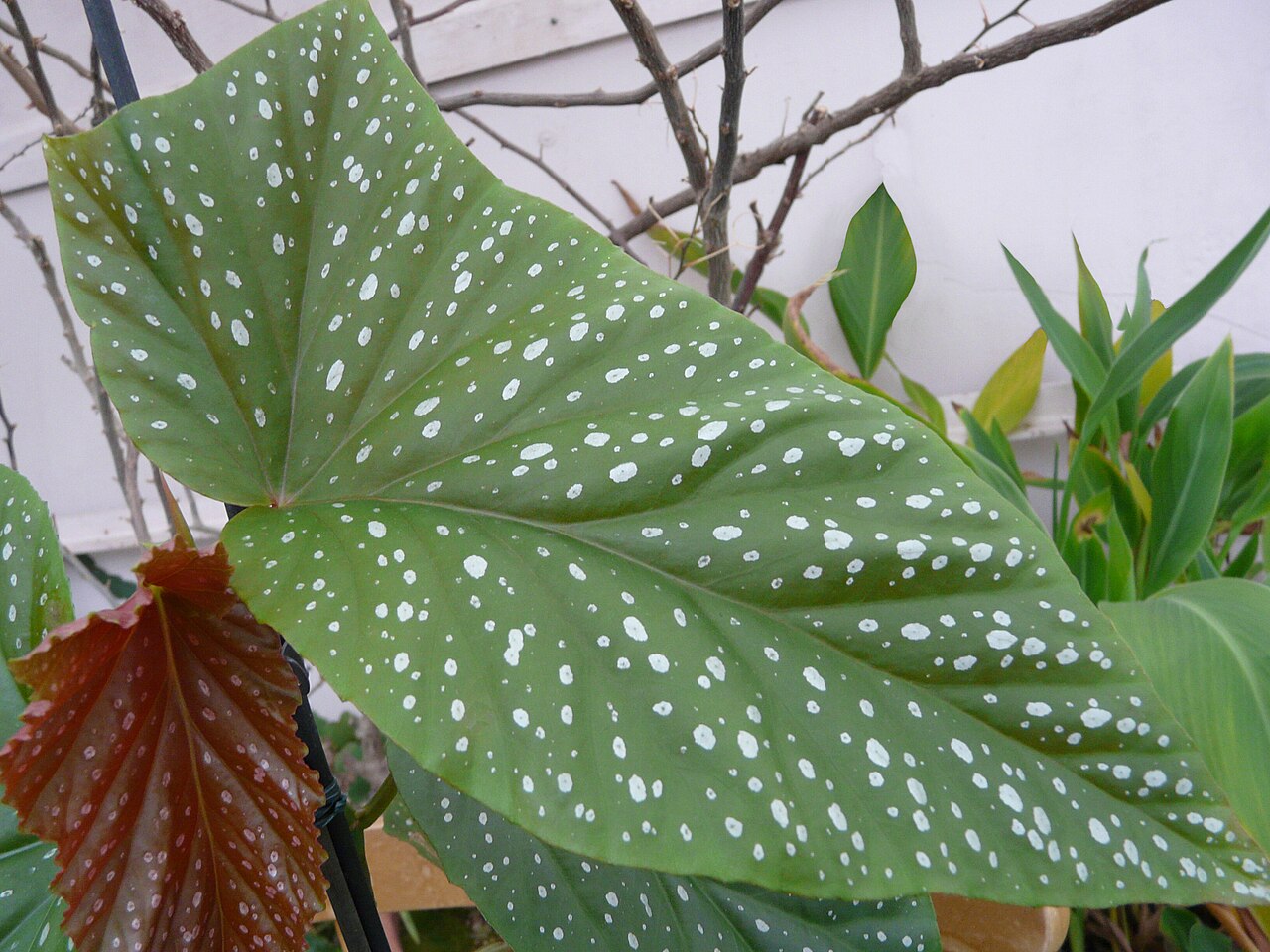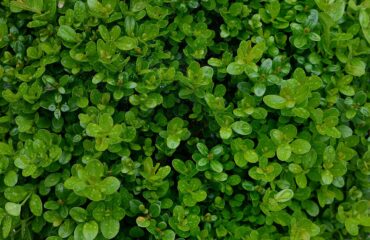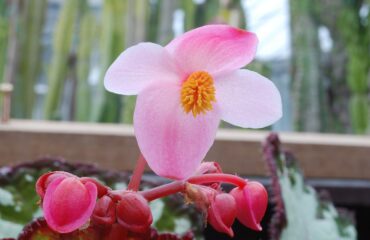Begonia maculata, commonly known as Polka Dot Begonia or Spotted Begonia, is a strikingly beautiful perennial plant native to the tropical rainforests of Brazil. It is highly prized for its unique foliage, featuring large, wing-shaped leaves adorned with silver-white polka dots on the upper surface and deep red to purple undersides. The leaves are often compared to angel wings or butterfly wings, adding a dramatic touch to any indoor or outdoor setting. In addition to its attractive foliage, Polka Dot Begonia produces clusters of delicate white or pink flowers that hang gracefully from red stems. Typically, the plant grows to a height of 12-24 inches (30-60 cm) and can spread 18-24 inches (45-60 cm). It is popular as a houseplant due to its ornamental value and relatively easy care.
Preferred Growing Conditions:
- Soil Type: Prefers well-drained, rich, organic soil; thrives in a mix of peat, perlite, and vermiculite or a commercial potting mix formulated for houseplants.
- Sunlight: Grows best in bright, indirect light; direct sunlight can scorch the leaves, so filtered light or partial shade is ideal. Indoors, place near a north or east-facing window.
- Temperature: Hardy in USDA zones 10-11; prefers temperatures between 65-75°F (18-24°C) and does not tolerate frost. Keep away from drafts and sudden temperature changes.
- Water Needs: Moderate; requires regular watering to keep the soil consistently moist but not waterlogged. Allow the top inch of soil to dry out between waterings.
Begonia Maculata (Spotted Begonia) Propagation Methods:
1. Stem Cuttings:
Stem cuttings are the most common and effective method for propagating Begonia maculata, allowing for the production of new plants that retain the characteristics of the parent.
- Types of Cuttings:
- Use softwood or semi-hardwood cuttings taken from healthy, mature plants.
- Preparation:
- Select healthy, non-flowering shoots and cut 4-6 inch sections just below a leaf node.
- Remove the lower leaves, leaving only the top few pairs of leaves on the cutting.
- Optionally, dip the cut end in rooting hormone to encourage faster rooting.
- Rooting in Water:
- Place the cuttings in a glass of water, ensuring the leaf nodes are submerged.
- Place the glass in a bright, indirect light location.
- Change the water every few days to keep it fresh and clear.
- Roots should begin to form within 2-4 weeks.
- Rooting in Soil:
- Alternatively, insert the cuttings directly into a well-draining potting mix, such as a blend of peat and perlite.
- Water lightly to settle the soil and place the pot in a bright, indirect light location.
- Cover the pot with a plastic bag or place in a propagation tray with a clear lid to maintain high humidity.
- Transplanting:
- Once roots are well-established and new growth appears, transplant the rooted cuttings into individual pots or directly into the garden.
- Gradually acclimate the new plants to outdoor conditions if they were started indoors.
2. Leaf Cuttings:
Propagating Begonia maculata from leaf cuttings is another effective method, particularly useful for producing multiple plants from a single leaf.
- Types of Cuttings:
- Use healthy, mature leaves for cuttings. The entire leaf or a section of it can be used.
- Preparation:
- Select a mature, healthy leaf and cut it from the plant, including a short section of the petiole (leaf stem).
- If using the whole leaf, make small slits along the main veins on the underside of the leaf.
- Alternatively, cut the leaf into sections, each with a main vein. Each section can produce a new plant.
- Planting:
- Place the leaf or sections on the surface of a well-draining potting mix, such as a blend of peat and perlite.
- Lightly press the leaf or sections into the soil, ensuring good contact but without burying them.
- Water lightly to settle the soil and place the pot in a bright, indirect light location.
- Cover the pot with a clear plastic bag or place in a propagation tray with a clear lid to maintain high humidity.
- Rooting:
- New roots and shoots should begin to form at the cut veins or edges within 4-8 weeks.
- Once new growth appears and the plantlets are large enough to handle, they can be separated from the parent leaf and transplanted into individual pots.
3. Division:
Division is a straightforward and effective method for propagating Begonia maculata, particularly for established clumps. This method helps rejuvenate the parent plant and produce new plants with identical characteristics.
- Timing:
- The best time for division is in early spring before new growth begins or in early autumn after the active growing season.
- Method:
- Carefully remove the plant from its pot and gently separate the root ball into smaller sections, ensuring each division has several shoots and a portion of the root system.
- Use a sharp knife or garden spade to divide the root ball if necessary.
- Remove any dead or damaged roots and foliage.
- Replanting:
- Replant the divisions immediately in prepared pots filled with a well-draining potting mix.
- Plant at the same depth as the original clump, spacing divisions to allow room for growth.
- Water thoroughly to settle the soil around the roots.
- Care After Division:
- Keep the newly planted divisions well-watered as they establish.
- Place the pots in a bright, indirect light location.
- Maintain high humidity and protect from strong drafts and sudden temperature changes during the initial recovery period.
4. Tissue Culture:
Tissue culture is an advanced propagation method used primarily in commercial settings to produce large numbers of uniform plants quickly. This method involves growing plant tissues in a sterile, controlled environment.
- Process:
- Small pieces of plant tissue, typically from the growing tips or meristem, are sterilized and placed in a nutrient-rich, sterile medium.
- Under controlled conditions, the tissue forms a callus, which then differentiates into shoots and roots.
- Once the plantlets are large enough, they are transferred to soil or a suitable growing medium to acclimate to normal growing conditions.
- Advantages:
- Produces a large number of uniform plants quickly.
- Can propagate disease-free plants and maintain rare or desired characteristics.
Care for Newly Propagated Plants:
- Place new plants in a location with bright, indirect light to encourage healthy growth and maintain the vibrant leaf colors.
- Water regularly to keep the soil consistently moist but not waterlogged.
- Maintain high humidity around the plants, especially if growing indoors or in dry environments.
- Feed with a balanced, water-soluble fertilizer every 4-6 weeks during the growing season to encourage healthy growth.
- Protect from strong drafts and sudden temperature changes to prevent stress.
Common Challenges and Solutions:
- Powdery Mildew: Ensure good air circulation around plants and avoid overhead watering. Treat with fungicides if necessary.
- Root Rot: Ensure good drainage and avoid waterlogging, especially in heavy soils or poorly ventilated containers.
- Spider Mites and Mealybugs: Monitor for common pests and treat infestations with insecticidal soap or neem oil.
Additional Tips:
- Rotate pots regularly to ensure even light exposure and prevent the plant from leaning towards the light.
- Clean leaves periodically to remove dust and allow for optimal light absorption.
- Avoid placing Polka Dot Begonia in direct sunlight, which can scorch the leaves and cause color fading.
- Use pots with drainage holes to prevent water accumulation and root rot when growing Begonia maculata in containers.
Conclusion:
Propagating Begonia maculata provides a rewarding opportunity to grow these striking and exotic plants in your home or garden. Whether you choose to start from stem cuttings, use leaf cuttings, divide larger plants, or explore tissue culture, with proper care and attention, Polka Dot Begonias will thrive and bring their unique foliage and delicate blooms to your space.
Share this article



